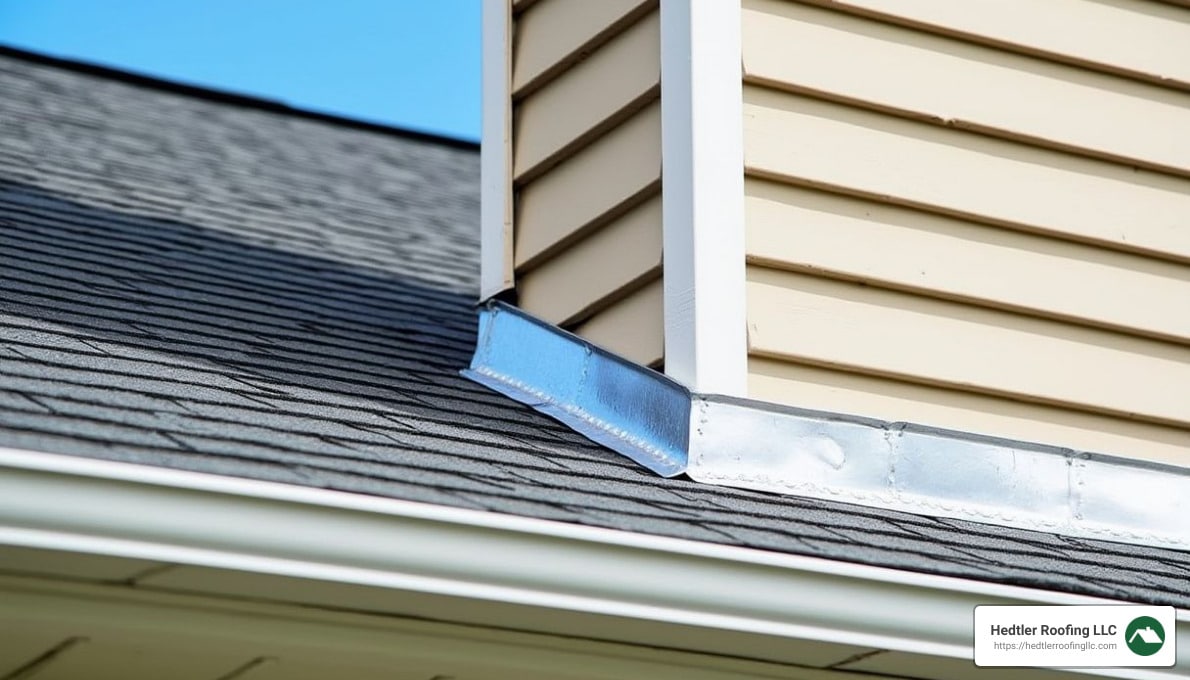Roof Flashing Repair: Top 5 Essential Tips in 2024
Roof flashing repair plays a crucial role in safeguarding your home from water damage and leaks. It’s the thin, moisture-resistant metal that redirects water away from areas on your roof where leaks might occur, such as chimneys, vents, and skylights. Without proper maintenance or repair, your home’s structural integrity could be compromised, leading to costly damages.
- Purpose: Redirects water away from vulnerable roof areas.
- Signs of Damage: Leaks, rust stains, visible gaps, or corrosion.
- Materials: Commonly used materials include aluminum, copper, and steel.
I’m Jason Hedtler, proud owner of Roof Experts with experience in roof flashing repair. Our team delivers top-notch roofing solutions to Massachusetts homeowners, ensuring your roofs are durable and aesthetically pleasing.

Handy roof flashing repair terms:
– ceiling leaking water
– handyman roof repair
– leaking roof
What is Roof Flashing?
Roof flashing is a crucial component in protecting your home from water damage. It consists of thin, moisture-resistant materials designed to redirect water away from vulnerable areas on your roof. These areas include chimneys, vents, skylights, and any place where the roof meets a vertical surface, like walls or dormers. Without effective flashing, water can seep into your home, leading to leaks and structural damage.
Types of Roof Flashing
Understanding the different types of roof flashing can help you identify potential problem areas and ensure your roof is properly protected:
- Continuous Flashing: Also known as apron flashing, this is a long piece of metal that directs water down to the shingles. It has expansion joints to accommodate the home’s movement.
- Base Flashing: Used in conjunction with counter-flashing, this type is essential for features like chimneys. It ensures water is directed downward.
- Counter-Flashing: Installed above or opposite base flashing, it completes the two-part system necessary for effective water diversion.
- Step Flashing: This type is used where the roof meets a wall. It’s installed in layers with shingles to guide water away from the wall.
- Skylight Flashing: Some skylights come with their own flashing, but it can also be custom-made to prevent leaks around skylights.
- Valley Flashing: Protects the valleys where two roof planes meet, a common area for water accumulation.
- Drip Edges: These are thin pieces of metal at the roof’s edge, helping water to drip off without damaging the structure.
- Kickout Flashing: Bridges the gap between step flashing and the gutter, directing water into the gutter system.
Materials Used in Roof Flashing
Choosing the right material for roof flashing is essential for durability and effectiveness. Here are some common materials used:
- Aluminum: Lightweight and easy to form, aluminum is a popular choice. However, it must be coated to prevent corrosion, especially in coastal areas.
- Copper: Known for its durability and ability to be soldered, copper flashing develops a patina over time, which some homeowners find appealing.
- Steel: Often the material of choice, galvanized steel is corrosion-resistant and aesthetically pleasing.
- Modified Bitumen Roofing Tape: This watertight material is used in specific applications, like in Florida, where building codes may require it.
Each material has its advantages, and the choice often depends on your specific needs and local building codes.
Signs Your Roof Flashing Needs Repair
Roof flashing is a vital part of your home’s defense against water damage. However, like all materials exposed to the elements, it can deteriorate over time. Recognizing the signs that your roof flashing repair is needed can save you from costly damage down the line.
Leaks and Water Ingress
One of the most obvious signs of flashing issues is water leaking into your home. If you notice water stains on your ceilings or walls, especially after a heavy rain, your flashing might be compromised.
Pro Tip: After a storm, check your attic for wet insulation or damp spots. Leaks often show up there first.
Corrosion and Rust Stains
Flashing is typically made of metal, which means it can rust or corrode over time, particularly if it’s not properly coated or if it’s made of a less durable material like plain aluminum. Look for rust stains around your roof’s edges or near any metal flashing components. Rust not only weakens the metal but also indicates potential water ingress points.
Visible Gaps
Flashing is supposed to create a seamless barrier against water. If you see visible gaps between the flashing and the roof surface, or if the flashing appears lifted or detached, it’s a clear sign that repairs are needed. Gaps can allow water to seep in, leading to leaks and potential structural damage.
Common Areas for Roof Flashing Issues
Certain areas of your roof are more prone to flashing problems. Here’s where to keep an eye out:
- Chimneys: Chimneys are notorious for flashing issues. The intersection of the chimney and roof is a common place for leaks, especially if the flashing is not properly installed or maintained. A Massachusetts homeowner found that rusty flashing around their chimney led to leaks and mold growth in their attic, costing thousands in repairs.
- Vents: Roof vents are essential for proper ventilation but can be leak sources if the flashing around them fails. Check for gaps or rust around vent pipes.
- Skylights: While many skylights come with their own flashing, they can still be problematic. Ensure the flashing is intact and properly sealed to prevent leaks.
- Valleys: Valleys are where two roof planes meet, directing a lot of water flow. Make sure valley flashing is in good condition to handle the water load.
- Dormers: These structures protrude from the roof and require special flashing attention. Look for signs of water damage or rust around dormer flashing.

By staying alert to these signs and regularly inspecting the common areas for flashing issues, you can prevent minor problems from turning into major headaches. In the next section, we’ll explore how to repair roof flashing effectively, whether you’re considering a DIY approach or hiring a professional.
How to Repair Roof Flashing
Step-by-Step Roof Flashing Repair Process
Repairing roof flashing involves several key steps. Each step ensures that the flashing remains watertight and your home stays protected from water damage.
1. Remove Shingles
To start a roof flashing repair, gently pry up the shingles surrounding the damaged flashing. This step is crucial because it allows access to the flashing without causing unnecessary damage to the shingles. Be careful, as shingles can be brittle and prone to breaking.
2. Address Minor Repairs
Once the shingles are removed, inspect the flashing for minor issues like small holes or corrosion. For small holes, roughen the edges around the hole, apply a flashing patch, and secure it with roofing cement. If the flashing is severely corroded, replacement is necessary.
3. Remove Fastening Materials
Carefully remove any nails, roofing mortar, or caulk securing the flashing. This step requires precision to avoid damaging the roof or surrounding materials. Once the fastening materials are removed, gently pry the flashing away from the roof.
4. Install New Flashing
With the old flashing removed, it’s time to install the new flashing. Make sure it fits snugly against the structure it’s protecting, whether it’s a chimney, vent, or dormer. Secure the flashing with nails, ensuring they are capped with roofing cement to maintain a watertight seal.
5. Reinstall Shingles
Finally, replace the shingles over the new flashing. Ensure they lie flat and are properly aligned to prevent water from seeping underneath. Secure the shingles with nails, and add a bead of roofing cement along the edges for extra protection against leaks.
DIY vs. Professional Roof Flashing Repair
While some homeowners might consider tackling roof flashing repair on their own, it’s important to weigh the complexity and risks involved.
Complexity and Risks
Repairing roof flashing is not as straightforward as it might seem. It requires a good understanding of roofing materials and techniques. Mistakes can lead to leaks, further damage, and costly repairs. Additionally, working on a roof can be dangerous without the proper safety equipment.
Benefits of Hiring Professionals
Hiring professionals like Roof Experts offers several advantages:
- Expertise: Professionals have the skills and experience to ensure the job is done right the first time. They understand the nuances of local building codes and the specific needs of Massachusetts homes.
- Safety: Roofing professionals are equipped with the right tools and safety gear to prevent accidents, ensuring both their safety and the integrity of your roof.
- Warranty: Many roofing companies provide warranties on their work, giving you peace of mind that any future issues will be addressed.
For Massachusetts homeowners, Roof Experts provides expert roof flashing repair services, ensuring your home stays dry and protected against the elements.
Cost of Roof Flashing Repair
Understanding the cost of roof flashing repair is essential for budgeting and planning. Here’s a breakdown of what you might expect when considering these repairs.
Average Costs
On average, homeowners spend between $150 and $8,000 on roof repairs, with flashing repair typically falling in the lower range of this spectrum. Minor flashing repairs, like fixing small leaks or replacing a few shingles, might cost between $150 and $1,500. However, if the damage is more extensive, involving major flashing replacement, costs can escalate to $1,500 to $8,000.
Factors Affecting Cost
Several factors influence the cost of repairing roof flashing:
- Extent of Damage: Minor repairs are less expensive than major repairs or complete replacements.
- Roof Complexity: Roofs with steep pitches or complex designs may require more labor and time, increasing costs.
- Accessibility: Easy-to-reach areas are cheaper to repair than those requiring special equipment or additional labor.
Labor Costs
Labor costs are a significant part of the repair budget. Roofers usually charge between $3 to $7 per square foot. The complexity of the work and the time required can affect the total labor cost. For example, a simple repair might take a few hours, while more complex jobs could take several days.
Material Costs
The choice of materials also impacts the overall cost. Common materials used for flashing include:
- Aluminum: Lightweight and easy to shape, but must be coated to prevent corrosion, especially in coastal areas.
- Copper: Durable and long-lasting, but more expensive. It develops a patina over time, which some homeowners like.
- Steel: Often galvanized for corrosion resistance, steel is a popular choice for its durability and aesthetic appeal.
Each of these materials comes with different price points, so discussing options with a roofing professional can help you decide what best fits your budget and needs.
By understanding these cost elements, you can better plan for your roof flashing repair project, ensuring you get quality work done within your budget. For Massachusetts homeowners, Roof Experts offers competitive pricing and expert services to keep your home protected.
Frequently Asked Questions about Roof Flashing Repair
How do you fix flashing on a roof?
Fixing roof flashing involves a few key steps to ensure your home stays dry and protected. Here’s how it’s done:
- Replace Damaged Sections: First, identify and remove any damaged or corroded flashing. It’s crucial to replace these sections to prevent leaks.
- Secure with Nails or Screws: Once the new flashing is in place, secure it with nails or screws. Make sure to fasten it properly to prevent it from coming loose in harsh weather.
- Ensure a Watertight Seal: Apply roofing cement or a suitable sealant along the edges of the flashing. This step is vital to keep water out and protect your home from damage.
For a more detailed guide, consider consulting a roofing professional, as improper repairs can lead to further issues.
Can I fix roof flashing myself?
While it’s possible to fix roof flashing yourself, there are important factors to consider:
- Correct Methods: You need to understand the proper techniques to ensure the flashing is installed correctly. Incorrect installation can lead to leaks and further damage.
- Materials and Tools: Make sure you have the right materials, such as the appropriate type of flashing and sealant, and tools like a hammer, nails, and a chisel.
- Safety Concerns: Working on a roof can be dangerous. If you’re not comfortable with heights or lack experience, it’s best to hire a professional.
For homeowners in Massachusetts, Roof Experts provides expert services that ensure your flashing is repaired safely and effectively.
Can you replace flashing without replacing the roof?
Yes, you can replace flashing without needing to replace the entire roof. This is often done in specific instances, such as:
- Localized Damage: If the flashing is the only part that’s damaged, you can replace it without affecting the rest of the roof.
- Flashing Fastened Behind a Wall: In some cases, flashing is installed behind walls or other structures. Professionals can carefully remove and replace it without disturbing the rest of the roof.
If you’re unsure about the condition of your flashing, a professional inspection can help determine the best course of action.
Conclusion
Regular maintenance of your roof flashing is crucial for the longevity and safety of your home. By ensuring this component is in good condition, you can prevent leaks and water damage that might otherwise lead to costly repairs. Roof flashing repair is not just about fixing leaks; it’s about safeguarding your home from the elements.
Professional Repairs Offer Peace of Mind
While DIY repairs might seem tempting, hiring a professional ensures the job is done right. Professionals have the expertise to spot issues that may be missed by an untrained eye. They also have the right tools and materials to perform a repair that will last. For homeowners in Massachusetts, Roof Experts offers reliable and high-quality roofing services. With over 20 years of experience, our team is dedicated to providing excellent workmanship and customer service in the Franklin and Bellingham areas.
Why Choose Roof Experts?
We understand the unique challenges of maintaining a roof in Massachusetts’ diverse climate. Our detailed inspections and custom solutions ensure that your roof remains in top condition, protecting your investment and enhancing the curb appeal of your home. Whether you need a simple repair or a complete roof replacement, our experts are here to help.
Contact Us Today
Don’t wait until a minor issue becomes a major problem. Regular inspections and timely repairs can save you time and money in the long run. For more information on our services or to schedule a consultation, visit our roof repairs page. Let us help you keep your roof in perfect condition, ensuring your home remains safe and beautiful for years to come.


